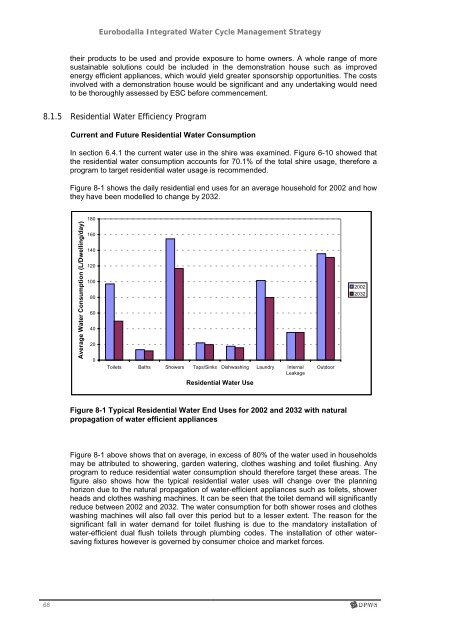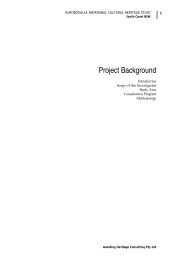Eurobodalla Integrated Water Cycle Management Strategy
Eurobodalla Integrated Water Cycle Management Strategy
Eurobodalla Integrated Water Cycle Management Strategy
Create successful ePaper yourself
Turn your PDF publications into a flip-book with our unique Google optimized e-Paper software.
68<br />
<strong>Eurobodalla</strong> <strong>Integrated</strong> <strong>Water</strong> <strong>Cycle</strong> <strong>Management</strong> <strong>Strategy</strong><br />
their products to be used and provide exposure to home owners. A whole range of more<br />
sustainable solutions could be included in the demonstration house such as improved<br />
energy efficient appliances, which would yield greater sponsorship opportunities. The costs<br />
involved with a demonstration house would be significant and any undertaking would need<br />
to be thoroughly assessed by ESC before commencement.<br />
8.1.5 Residential <strong>Water</strong> Efficiency Program<br />
Current and Future Residential <strong>Water</strong> Consumption<br />
In section 6.4.1 the current water use in the shire was examined. Figure 6-10 showed that<br />
the residential water consumption accounts for 70.1% of the total shire usage, therefore a<br />
program to target residential water usage is recommended.<br />
Figure 8-1 shows the daily residential end uses for an average household for 2002 and how<br />
they have been modelled to change by 2032.<br />
Average <strong>Water</strong> Consumption (L/Dwelling/day)<br />
180<br />
160<br />
140<br />
120<br />
100<br />
80<br />
60<br />
40<br />
20<br />
0<br />
Toilets Baths Showers Taps/Sinks Dishwashing Laundry Internal<br />
Leakage<br />
Residential <strong>Water</strong> Use<br />
Outdoor<br />
Figure 8-1 Typical Residential <strong>Water</strong> End Uses for 2002 and 2032 with natural<br />
propagation of water efficient appliances<br />
Figure 8-1 above shows that on average, in excess of 80% of the water used in households<br />
may be attributed to showering, garden watering, clothes washing and toilet flushing. Any<br />
program to reduce residential water consumption should therefore target these areas. The<br />
figure also shows how the typical residential water uses will change over the planning<br />
horizon due to the natural propagation of water-efficient appliances such as toilets, shower<br />
heads and clothes washing machines. It can be seen that the toilet demand will significantly<br />
reduce between 2002 and 2032. The water consumption for both shower roses and clothes<br />
washing machines will also fall over this period but to a lesser extent. The reason for the<br />
significant fall in water demand for toilet flushing is due to the mandatory installation of<br />
water-efficient dual flush toilets through plumbing codes. The installation of other watersaving<br />
fixtures however is governed by consumer choice and market forces.<br />
2002<br />
2032

















